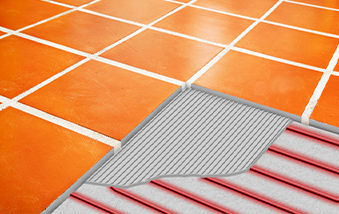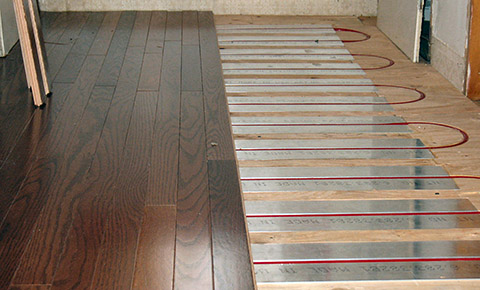Radiant heat has become a popular home heating solution nowadays. As the demand for clean, renewable heating sources continues to increase, radiant heat has become one of the most popular home heating technologies today. Energy-efficient radiant heat is used for heating floors as well as for driveway snow melting applications, roof de-icing, and even pipe freeze prevention.
Radiant heat involves the transfer of energy that radiates heat outward from its source. This heating method makes radiant heat the most efficient heating technology available, where virtually no energy is wasted. A radiant floor heating system features a heating element embedded beneath the floor to effectively heat the floor as well as objects in contact with the floor. Unlike traditional forced-air systems that blow warm air through vents, where it quickly rises to the ceiling, radiant heat originates from the ground up, providing a uniquely rich warming experience. Heated floors are particularly well-suited for rooms where children spend most of their time playing on the floor.

A wide variety of proven floor heating systems are available from Warmzone.com. These systems range from thin heat cable to flexible, low-voltage polymer heating panels, and even near paper-thin heating panels. Each system is designed to produce the best results for heating specific floor types. Radiant heat systems can be installed under just about any type of floor surface, and customized to meet the specifics of virtually any application.
There are two basic methods for providing radiant heat – electric systems and hydronic systems. Electric radiant heating systems utilize a network of electrical resistance heat cable (heating element) that is embedded under the floor surface. Hydronic systems pump specially treated water through flexible Pex tubing under the floor. The liquid is re-circulated in a closed loop system between the network of tubing and the boiler. Both types of radiant floor heating systems provide a much more efficient means of heating than that of traditional forced air systems.
Another advantage of radiant heated floors is that the systems consist of "zones" that can be controlled individually. This gives you precise control over your heating system by granting you the flexibility to heat only the specific rooms or areas that you choose. A small, high-tech programmable thermostat with either an external sensor (to measure ambient room temperature) or built-in sensor (to measure floor temperature) is used to control each zone.

Electric floor heating systems utilize heat cable to generate the heat source. When in operation, energy is forced through a conductive material (heat cable) to create resistance (heat). For most areas an electric line-voltage system is used. The heated floor system's thermostat has an integrated GFCI breaker at the power source to ensure safety, and is available in 110 or 220 voltage. The line-voltage products most recommended are ComfortTile® and Warmzone Prodeso® and In-Slab™ heat cables.
Low-voltage systems use the same voltages and consume the same amount of power as line-voltage products. The main difference is the use of a step-down transformer which reduces the voltage supplied to the heating materials. Due to their low-voltage current (8-30v), heating elements like FloorHeat STEP® (perhaps the most trusted low-voltage system available), can be safely nailed and stapled down to secure the product to the floor and are therefore useful for installation under hardwood and carpet. One of the most recommended low-voltage radiant heat products is the proven FloorHeat system.
With hydronic floor heating systems, specially treated water is heated by a boiler and then pumped through a closed loop series of special PEX tubing that is installed under the floor. The heated liquid produces warmth that radiates across the floor's surface. Hydronic underfloor heating is still the most popular form of radiant heat, mainly because it has been around the longest. Hydronic heating was first used by the Romans thousands of years ago, but naturally, there have been significant developments since.
 In the most recent hydronic floor heating systems, PEX radiant tubing is routed in the grooves of
aluminum panels (shown left). The advanced panels are recommended as the most effective hydronic
underlayment system because of the aluminum's reflective properties and light weight.
In the most recent hydronic floor heating systems, PEX radiant tubing is routed in the grooves of
aluminum panels (shown left). The advanced panels are recommended as the most effective hydronic
underlayment system because of the aluminum's reflective properties and light weight.
The aluminum panel floor heating system is designed to provide rapid response, optimal performance and ease of installation. This effective floor heating system is an excellent alternative to joist heating and poured thermal mass applications. The system consists of 3/8-inch tubing, extruded aluminum panels for strength, and wood return bends. The aluminum panels offer high conductivity with a low profile and a low mass, and eliminate the need for structural reinforcement. The hydronic system is easy to install, and requires less job site preparation and installation time than other systems.
While electric heated floors are often recommended over hydronic systems, there is still a place for hydronic floor heating and snow melting applications. Hydronic radiant heat is frequently used for large commercial radiant heat applications because the operational cost can be slightly less than that of electric radiant heating systems, depending on local utility rates.
Different thermostats are available to control your radiant floor heating system. You can choose a thermostat that is controlled by a floor sensor (that measures floor temperature) or opt for one with an ambient sensor that measures the actual temperature in a specific room.
For more information about floor heating systems — or snow melting — contact a friendly Warmzone® radiant heat professional today at 888.488.9276.